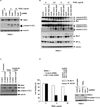Sorafenib inhibits STAT3 activation to enhance TRAIL-mediated apoptosis in human pancreatic cancer cells
- PMID: 20197401
- PMCID: PMC3281304
- DOI: 10.1158/1535-7163.MCT-09-1004
Sorafenib inhibits STAT3 activation to enhance TRAIL-mediated apoptosis in human pancreatic cancer cells
Abstract
Signal transducers and activators of transcription 3 (STAT3) is constitutively active in human pancreatic cancer cells and can promote cell growth and apoptosis resistance that contribute to tumorigenesis. We determined if sorafenib, a multikinase inhibitor, can induce apoptosis by targeting STAT3 signaling to enhance apoptosis induction by tumor necrosis factor-related apoptosis-inducing ligand (TRAIL). Human pancreatic cancer cell lines (PANC-1 and BxPC-3) were preincubated with sorafenib (Nexavar) alone or followed by TRAIL. Apoptosis was determined by Annexin V labeling, caspase cleavage, and Bax/Bak activation. Protein expression was analyzed by immunoblotting. Knockdown of STAT3, Mcl-1, and Bim were achieved by lentiviral small hairpin RNA. Adenoviral dominant-negative or retroviral constitutively active (CA) STAT3 were also used. Sorafenib inhibited constitutive STAT3 phosphorylation (Tyr(705)) and suppressed Mcl-1 and Bcl-x(L) proteins in a dose- and time-dependent manner. CA-STAT3 overexpression was shown to attenuate caspase-3 cleavage and suppression of Mcl-1 by sorafenib. STAT3 knockdown or a DN STAT3 was shown to downregulate Mcl-1 and Bcl-x(L) and to sensitize cells to TRAIL-mediated apoptosis. Treatment with sorafenib enhanced TRAIL-induced Annexin V staining and release of mitochondrial cytochrome c and AIF. Because the BH3-only Bim protein is a potent inducer of mitochondrial apoptosis, Bim knockdown was shown to attenuate caspase-3, caspase-9 cleavage, and Bax/Bak activation by sorafenib plus TRAIL. The suppression of STAT3 by genetic means or using sorafenib was shown to downregulate Mcl-1 and Bcl-x(L) and to sensitize cells to TRAIL-mediated apoptosis. These data indicate that targeting STAT3 may enhance treatment efficacy against pancreatic cancer.
Conflict of interest statement
No potential conflicts of interest were disclosed.
Figures





Similar articles
-
The multikinase inhibitor sorafenib potentiates TRAIL lethality in human leukemia cells in association with Mcl-1 and cFLIPL down-regulation.Cancer Res. 2007 Oct 1;67(19):9490-500. doi: 10.1158/0008-5472.CAN-07-0598. Cancer Res. 2007. PMID: 17909059
-
Mcl-1 as a buffer for proapoptotic Bcl-2 family members during TRAIL-induced apoptosis: a mechanistic basis for sorafenib (Bay 43-9006)-induced TRAIL sensitization.J Biol Chem. 2007 Oct 12;282(41):29831-46. doi: 10.1074/jbc.M706110200. Epub 2007 Aug 13. J Biol Chem. 2007. PMID: 17698840
-
BH3 mimetic obatoclax enhances TRAIL-mediated apoptosis in human pancreatic cancer cells.Clin Cancer Res. 2009 Jan 1;15(1):150-9. doi: 10.1158/1078-0432.CCR-08-1575. Clin Cancer Res. 2009. PMID: 19118042 Free PMC article.
-
Sorafenib inhibits ERK1/2 and MCL-1(L) phosphorylation levels resulting in caspase-independent cell death in malignant pleural mesothelioma.Cancer Biol Ther. 2009 Dec;8(24):2406-16. doi: 10.4161/cbt.8.24.10824. Epub 2009 Dec 2. Cancer Biol Ther. 2009. PMID: 20038816 Free PMC article.
-
STAT3 as a target for inducing apoptosis in solid and hematological tumors.Cell Res. 2008 Feb;18(2):254-67. doi: 10.1038/cr.2008.18. Cell Res. 2008. PMID: 18227858 Free PMC article. Review.
Cited by
-
Synergistic inhibitory effect of hyperbaric oxygen combined with sorafenib on hepatoma cells.PLoS One. 2014 Jun 23;9(6):e100814. doi: 10.1371/journal.pone.0100814. eCollection 2014. PLoS One. 2014. PMID: 24956259 Free PMC article.
-
Crosstalk of Sp1 and Stat3 signaling in pancreatic cancer pathogenesis.Cytokine Growth Factor Rev. 2012 Feb-Apr;23(1-2):25-35. doi: 10.1016/j.cytogfr.2012.01.003. Epub 2012 Feb 16. Cytokine Growth Factor Rev. 2012. PMID: 22342309 Free PMC article. Review.
-
Dual Inhibition of SRC Family Kinases and Sorafenib Enhances Anti-Tumor Activity in Hepatocellular Carcinoma Cells.Int J Mol Sci. 2025 Jul 6;26(13):6506. doi: 10.3390/ijms26136506. Int J Mol Sci. 2025. PMID: 40650282 Free PMC article.
-
Sorafenib decreases proliferation and induces apoptosis of prostate cancer cells by inhibition of the androgen receptor and Akt signaling pathways.Endocr Relat Cancer. 2012 May 3;19(3):305-19. doi: 10.1530/ERC-11-0298. Print 2012 Jun. Endocr Relat Cancer. 2012. PMID: 22383427 Free PMC article.
-
Pancreatic ductal adenocarcinoma: a review of immunologic aspects.J Investig Med. 2012 Apr;60(4):643-63. doi: 10.2310/JIM.0b013e31824a4d79. J Investig Med. 2012. PMID: 22406516 Free PMC article. Review.
References
-
- Jemal A, Murray T, Ward E, et al. Cancer statistics, 2005. CA Cancer J Clin. 2005 Jan–Feb;55(1):10–30. - PubMed
-
- Reed JC. Drug insight: cancer therapy strategies based on restoration of endogenous cell death mechanisms. Nature clinical practice. 2006 Jul;3(7):388–398. - PubMed
-
- Scholz A, Heinze S, Detjen KM, et al. Activated signal transducer and activator of transcription 3 (STAT3) supports the malignant phenotype of human pancreatic cancer. Gastroenterology. 2003 Sep;125(3):891–905. - PubMed
-
- Yu H, Jove R. The STATs of cancer--new molecular targets come of age. Nat Rev Cancer. 2004 Feb;4(2):97–105. - PubMed
-
- Darnell JE., Jr STATs and gene regulation. Science. 1997 Sep 12;277(5332):1630–1635. - PubMed
Publication types
MeSH terms
Substances
Grants and funding
LinkOut - more resources
Full Text Sources
Medical
Research Materials
Miscellaneous

